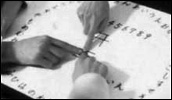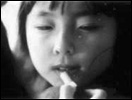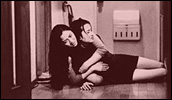Kokkuri
- Year
- 1997
- Original title
- Kokkuri-san
- Japanese title
- こっくりさん
- Director
- Cast
- Running time
- 87 minutes
- Published
- 22 December 2005



by Jim Harper
Despite the sustained interest in Japanese horror and Takahisa Zeze's growing reputation as a director, as well as an appearance at the 1997 Venice Film Festival, Kokkuri has received relatively little coverage or publicity. This probably has something to with the nature of the film; despite being commissioned by Nikkatsu to coincide with the growing interest in teen horror, it's a dark and sombre effort that concentrates on the difficulties of adolescent emotions rather than the mischievous spirits that are believed to control the kokkuri, or ouija board.
Mio (Ayumi Yamatsu), Hiroko (Hiroko Shimada), and Masami (Moe Ishikawa) are three Tokyo schoolgirls with typical teenage interests: boys, friendship and hanging around shopping malls. One of their favourite activities is listening to 'Michiru', a radio presenter who appears to be roughly the same age as the girls themselves. She's a confident, streetwise type, sexually experienced, and open about her life. Unsurprisingly she's idolized by some of her more impressionable listeners. Unknown to her friends, 'Michiru' is none other than Mio, and her radio persona is almost entirely a sham. Hiroko has her own secret too: she's in love with Masami's boyfriend Akira, and Masami is beginning to suspect that her friend cannot be trusted.
Following a suggestion from 'Michiru', the girls create a ouija board and prepare to ask the spirit to reveal some details about the mysterious radio presenter (these are then supposed to be sent to the station, to see who comes up with the most accurate answers). However, with tensions between Hiroko and Masami nearing breaking point, few of the questions deal with 'Michiru'. Each of the girls receives a momentous revelation that night: 'Michiru' will be dead before her 18th birthday, less than a month away; Masami's relationship with Akira will not last much longer; and Hiroko will meet the love of her life soon. While Mio keeps quiet and shrugs off the portent of doom, Masami runs off in tears. The only one pleased with the result is Hiroko, who assumes that the person in question is Akira.
Naturally all three prophecies come true in the end and, this being a horror movie, not in the way the girls first think. Thankfully we are spared any Wishmaster-style twists-in-the-tail. Instead the emphasis is on the emotional responses of the girls, mainly Hiroko and Mio. These two share a deeper connection based upon separate past experiences. As a child, Mio saw her mother drown after she saved Mio from a strong sea current, while Hiroko's friend Midori accidentally drowned in her bathtub after the pair had been playing with a ouija board. Like many survivors, Mio feels that she was supposed to drown with her mother, and believes that Midori had to die as well to take her place. As well as visions of her mother's death, Mio has also seen a small figure in a red rain slicker following her. Is it Midori, returned to take revenge?
Red is the colour of Mio's guilt: the colour of her mother's lipstick on the day she drowned, and the colour of the raincoat worn by the phantom visitor. Given that the majority of the film is shot either in partial darkness or in drab, brown surroundings, the flashes of bright red leap off the screen. In Kokkuri red is almost always associated with feelings of guilt and regret, underscoring the film's main themes. The other prominent symbol is of course water, occurring in almost every scene, from the sea itself to fish tanks and leaking pipes. Although water plays a pivotal role in the psychological collapse of the protagonists, by the end Zeze returns to the more neutral concept of water as the ultimate physical and spiritual cleanser, embodying both destruction and subsequent rebirth.
Arriving as it did just before the horror revival that followed Hideo Nakata's Ring, Kokkuri is thankfully free of the hand-me-down clichés that have plagued later Japanese horror films. Zeze does briefly use the traditional white-robed, dark-haired ghost, but she is usually dressed in a red raincoat, an open reference to Nicolas Roeg's Don't Look Now (1973), another film about a drowning child. The bouncing ball from Peter Medak's The Changeling (1980) makes an appearance too, this time coloured red. The derelict buildings and limited palette of greys and browns also suggest that Kiyoshi Kurosawa's Cure may have been an influence.
Like the Korean hit Memento Mori, Kokkuri is primarily an attempt to portray the emotional turmoil of adolescence using the conventions of a horror film. Thankfully both films ditch the more clichéd trappings in favour of solid performances and well-drawn characters. Although there's plenty of evidence here that Zeze could make a decent name for himself as a horror director, it is his sensitive approach to the material that makes Kokkuri such a memorable film.